— Solving Endurance Challenges with Bitpott Solar Garden Lights as an Example
As dusk falls, Bitpott solar garden lights illuminate with a warm glow, gently outlining garden paths. As eco-friendly fixtures powered by light energy, their core strength lies in harnessing nature. However, during prolonged rainy days or short winter daylight hours, many users wonder: Do solar garden lights truly never require manual charging? How can their light persist without sunlight? This article dives into Bitpott’s product features, offering a detailed analysis from technical principles to practical solutions.

Understanding the “Charging Essence” of Solar Garden Lights
Solar Lights Are Not Perpetual Motion Machines
Bitpott solar garden lights operate on a conversion chain: light energy → electrical energy → chemical energy → light energy:
- Daytime: Polycrystalline silicon solar panels absorb light, converting 18%-22% of it into electricity via the photovoltaic effect.
- Storage: Electricity is stored in a 2200mAh lithium battery through an MPPT smart controller, retaining 85% capacity in low temperatures.
- Nighttime: Light sensors trigger the LED array, consuming ~300mAh for 6-8 hours of nightly illumination.
Why Is “Supplementary Charging” Necessary?
Even with industry-leading storage systems, manual intervention is needed in these scenarios:
- Consecutive Rainy Days (>3 days): Daily sunlight <2 hours, battery self-discharge (5%-8% monthly) outpaces energy replenishment.
- Extreme Temperatures: At -20°C, battery activity drops, reducing effective capacity by 30%, requiring external activation.
- Long-Term Inactivity: If unused for over 2 months, charge to 50% for storage to prevent sulfation.
Key Conclusion: Solar lights are a hybrid energy system—primarily natural light, supplemented by manual charging. Proper intervention can extend lifespan by over 30%.
Three Charging Solutions for Sunless Scenarios (Bitpott-Specific Guide)
Option 1: Type-C Emergency Charging (★★★★★)
All Bitpott garden lights feature a hidden Type-C port (under a waterproof cover at the base), supporting 5V/1A input:
- Connect using a phone charger or power bank.
- Charging indicator shows steady red, turning green when full (~4 hours).
- Recommend monthly “shallow charging” to 80% to avoid overcharging.

Technical Advantage: Smart anti-reverse charging circuitry cuts off solar panel input during charging, preventing current conflicts that could damage the battery.
Option 2: Indoor Light Charging (Ideal for Cloudy Weather)
For a quick power boost, place the light near an indoor window:
- Use an LED desk lamp with >6500K color temperature, positioned 30cm away.
- Ensure light intensity exceeds 2000lux (measurable via a phone illuminance app).
- Charging efficiency is ~1/5 of direct sunlight; 8 hours adds ~15% battery.
Practical Tip: Leverage Bitpott’s patented rotatable lamp head to align the solar panel directly with the light source for optimal absorption.
Option 3: External Solar Panel Expansion (Advanced Solution)
For users in low-sunlight regions like Northern Europe or high latitudes, Bitpott offers a compatible 10W external solar panel:
- Connects to the main light via a waterproof extension cable (up to 5m).
- Install on rooftops or sunnier spots, boosting charging efficiency by 40%.
- Supports parallel connection with the main light’s battery for “dual-panel charging.”
Data Comparison: In 3-hour daily scattered light, a single light lasts 12 days; with an external panel, endurance extends to 22 days.
Scientific Maintenance to Boost Charging Efficiency by 50%
Battery Activation Cycle Management
- First Use: Charge in sunlight for 12 hours to activate battery performance.
- Winter Care: Below 0°C, charge via Type-C monthly to prevent battery dormancy.
- Long-Term Storage: Store at 50% charge, topping up to 60% every 3 months.
Hardware Maintenance Tips
- Regular Cleaning: Wipe the solar panel with a soft cloth (monthly, or weekly in dusty conditions).
- Angle Adjustment: Adjust panel tilt seasonally (15° in summer, 45° in winter for Northern Hemisphere).
- Waterproof Check: Replace the charging port’s rubber seal annually (contact official support for parts).
Common User Questions (QA)
Q1: If I forget to charge and the light stops working, will it harm the battery?
A: Occasional full discharge won’t damage the battery, but charge promptly when below 20%. Deep discharge (<5%) may cause sulfation, reducing cycle life.
Q2: Can I use a fast charger for Bitpott lights?
A: Avoid chargers >2A, as high currents may trigger overcharge protection. Stick to 5V/1A for optimal results.
Q3: Can I use third-party external solar panels?
A: Third-party panels may have voltage mismatches. Bitpott’s official panels are tested for compatibility, ensuring efficient MPPT controller performance.
Harmonizing Technology with Nature
Bitpott solar garden lights embody a design philosophy that balances environmental ideals with practical needs—maximizing renewable energy while offering solutions for challenging climates. Through the convenience of Type-C charging, the flexibility of indoor light charging, and the scalability of external panels, users in regions with polar nights or frequent rain, like Northern Europe or the UK, can effortlessly maintain control over their lighting.
By mastering scientific methods to coexist with nature, the thoughtful details in Bitpott’s charging design translate into reliable light every night. True green technology isn’t about exploiting nature but knowing when to gently intervene, ensuring the sun’s gift illuminates our lives more enduringly.


Leave a Reply